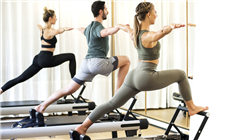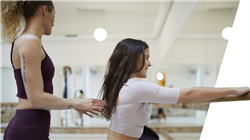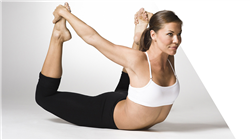University certificate
The world's largest faculty of physiotherapy”
Why study at TECH?
With this Hybrid professional master’s degree, you will access a complete and specialized program in the application of the Pilates method for the rehabilitation and treatment of various pathologies”

Therapeutic Pilates has established itself as a popular technique to treat spinal problems, joints and post-surgical rehabilitation. Its main objective is to strengthen deep muscles, improve posture and relieve chronic pain, especially in people with injuries or conditions such as Scoliosis, Herniated Discs or Osteoarthritis.
This is how this Hybrid professional master’s degree was born, which will prepare professionals in the application of the Pilates method as a therapeutic tool. In its first stages, it will delve into the origins and history of Pilates, analyzing how it has evolved to become a recognized method in physical rehabilitation. In addition, the fundamentals of the method will be analyzed, understanding the theoretical and practical bases, identifying the most relevant exercises, as well as the positions that should be avoided to prevent injuries.
Likewise, physiotherapists will acquire knowledge about the environment in which Pilates is practiced, from the description of the gym and the machines used, to the protocols and progressions of exercises suitable for different types of patients. The different ways of structuring the sessions will also be addressed, adjusting the methodology to the specific needs of each person.
Finally, the application of Pilates for the treatment of various pathologies, such as alterations of the spine, upper and lower limbs, and other health conditions, will be discussed. Therefore, specific cases will be examined, such as the application of Pilates during pregnancy, childbirth and postpartum, ensuring that the exercises are appropriate for each phase. In turn, it will delve into the most common injuries in the sports field, providing prevention and recovery strategies.
In this way, TECH has developed a complete program that will be divided into two sections. The first, fully online, will focus on theory, using the revolutionary Relearning methodology, consisting of continuous reiteration of key concepts for optimal assimilation of content. The second section will consist of a 3-week practical stay in a leading clinic.
Would you like to perfect your skills in Sports Medicine and Physical Rehabilitation? You will have access to 10 additional Masterclasses, designed by an internationally renowned specialist in this area”
This Hybrid professional master’s degree in Therapeutic Pilates contains the most complete and up-to-date scientific program on the market. The most important features include:
- Development of more than 100 clinical cases presented by physiotherapy professionals, experts in Therapeutic Pilates and university professors with extensive experience in this field
- The graphic, schematic, and practical contents with which they are created, provide scientific and practical information on the disciplines that are essential for professional practice
- Comprehensive systematized action plans for the main pathologies in physiotherapy
- Presentation of practical workshops on procedures diagnosis, and treatment techniques
- Algorithm-based interactive learning system for decision making in the situations that are presented to the student
- Practice guidelines on the approach to different pathologies
- All of this will be complemented by theoretical lessons, questions to the expert, debate forums on controversial topics, and individual reflection assignments
- Content that is accessible from any fixed or portable device with an Internet connection
- In addition, they will be able to do an internship in one of the best centers and clinics in the world
You will obtain a solid theoretical and practical base that will facilitate your insertion into the workplace in the areas of health, wellness and physical activity, thanks to an extensive library of innovative multimedia resources”
In this Hybrid professional master’s degree proposal, of professionalizing character and blended learning modality, the program is aimed at updating physiotherapy professionals who develop their functions in Therapeutic Pilates, and who require a high level of qualification. The contents are based on the latest scientific evidence, and oriented in a didactic way to integrate theoretical knowledge in the practice of physiotherapy, and the theoretical-practical elements will facilitate the updating of knowledge and allow decision making in patient management.
Thanks to the multimedia content, developed with the latest educational technology, Physiotherapy professionals will benefit from contextual learning, i.e., a simulated environment that will provide immersive learning programmed to specialize in real situations. This program is designed around Problem-Based Learning, whereby the physician must try to solve the different professional practice situations that arise during the course. For this purpose, students will be assisted by an innovative interactive video system created by renowned and experienced experts.
You will delve into the controversies surrounding the correct application of the Pilates method, ensuring a practice based on the latest scientific evidence and oriented to patient safety"

You will analyze the most common injuries in sports, providing prevention and recovery strategies by adapting exercises according to the sport practiced"
Teaching Planning
Throughout the program, physiotherapists will analyze the background and methodology of Pilates, delving into its fundamentals and the most relevant exercises, as well as the positions to avoid to ensure safety. Aspects of the work environment will also be examined, including the description of the gym and the use of specific machinery. In addition, spinal and extremity disorders will be addressed, providing adapted exercise protocols for injury rehabilitation.

You will delve into topics about Pilates during pregnancy and its application in sport, allowing you to adapt your knowledge to different populations. What are you waiting for to enroll?"
Module 1. Pilates Method
1. 1. Joseph Pilates
1.1.1. Joseph Pilates
1.1.2. Books and Postulates
1.1.3. Legacy
1.1.4. Origin of the Personalized Exercise
1.2. Background of the Pilates Method
1.2.1. References
1.2.2. Evolution
1.2.3. Current Situation
1.2.4. Conclusions
1.3. Evolution of the Method
1.3.1. Improvements and Modifications
1.3.2. Contributions to the Pilates Method
1.3.3. Therapeutic Pilates
1.3.4. Pilates and Physical Activity
1.4. Pilates Method Principles
1.4.1. Definition of the Principles
1.4.2. Evolution of the Principles
1.4.3. Levels of Progression
1.4.4. Conclusions
1.5. Classical vs. Contemporary/Modern Pilates
1.5.1. Key Points in Classical Pilates
1.5.2. Modern/Classical Pilates Analysis
1.5.3. Contributions of Modern Pilates
1.5.4. Conclusions
1.6. Pilates Floor and Pilates Machines
1.6.1. Fundamentals in Pilates Floor
1.6.2. Evolution of Pilates Floor
1.6.3. Fundamentals in Pilates Machines
1.6.4. Evolution in Pilates Machines
1.7. Scientific Evidence
1.7.1. Scientific Journals Related to Pilates
1.7.2. Doctoral Theses on Pilates
1.7.3. Pilates Publications
1.7.4. Applications for Pilates
1.8. Pilates Method Orientations
1.8.1. National Trends
1.8.2. International Trends
1.8.3. Trend Analysis
1.8.4. Conclusions
1.9. Schools
1.9.1. Pilates Training Schools
1.9.2. Magazines
1.9.3. Evolution of Pilates Schools
1.9.4. Conclusions
1.10. The Pilates Associations and Federations
1.10.1. Definitions
1.10.2. Benefits
1.10.3. Objectives
1.10.4. LDC
Module 2. Pilates Method Fundamentals
2.1. The Different Concepts of the Method
2.1.1. The Concepts According to Joseph Pilates
2.1.2. Evolution of Concepts
2.1.3. Later Generations
2.1.4. Conclusions
2.2. Breathing
2.2.1. The Different Types of Breathing
2.2.2. Analysis of Types of Breathing
2.2.3. The Effects of Breathing
2.2.4. Conclusions
2.3. The Pelvis as the Center of Stability and Movement
2.3.1. The Core of Joseph Pilates
2.3.2. The Scientific Core
2.3.3. Anatomical Foundation
2.3.4. Core in Recovery Processes
2.4. The Organization of the Shoulder Girdle
2.4.1. Anatomical Review
2.4.2. Biomechanics of the Shoulder Girdle
2.4.3. Applications in Pilates
2.4.4. Conclusions
2.5. The Organization of Lower Limb Movement
2.5.1. Anatomical Review
2.5.2. Biomechanics of the Lower Limb
2.5.3. Applications in Pilates
2.5.4. Conclusions
2.6. The Articulation of the Spine
2.6.1. Anatomical Review
2.6.2. Biomechanics of the Spine
2.6.3. Applications in Pilates
2.6.4. Conclusions
2.7. Alignments of Body Segments
2.7.1. Posture
2.7.2. Posture in Pilates
2.7.3. Segmental Alignments
2.7.4. Muscular and Fascial Chains
2.8. Functional Integration
2.8.1. Concept of Functional Integration
2.8.2. Implications in Different Activities
2.8.3. The Task
2.8.4. The Context
2.9. Fundamentals of Therapeutic Pilates
2.9.1. History of Therapeutic Pilates
2.9.2. Concepts in Therapeutic Pilates
2.9.3. Criteria in Therapeutic Pilates
2.9.4. Examples of Injuries or Pathologies
2.10. Classic Pilates and Therapeutic Pilates
2.10.1. Differences Between Both Methods
2.10.2. Justification
2.10.3. Progressions
2.10.4. Conclusions
Module 3. Pilates Gym
3.1. The Reformer
3.1.1. Introduction to the Reformer
3.1.2. Benefits of the Reformer
3.1.3. Main Exercises on the Reformer
3.1.4. Main Errors on the Reformer
3.2. The Cadillac or Trapeze Table
3.2.1. Introduction to the Cadillac
3.2.2. Benefits of the Cadillac
3.2.3. Main Exercises in the Cadillac
3.2.4. Main Errors in the Cadillac
3.3. The Chair
3.3.1. Introduction to the Chair
3.3.2. Benefits of the Chair
3.3.3. Main Exercises in the Chair
3.3.4. Main Errors in the Chair
3.4. The Barrel
3.4.1. Introduction to the Barrel
3.4.2. Benefits of the Barrel
3.4.3. Main Exercises in the Barrel
3.4.4. Main Errors in the Barrel
3.5. Combo Models
3.5.1. Introduction to the Combo Model
3.5.2. Benefits of the Combo Model
3.5.3. Main Exercises in the Combo Model
3.5.4. Main Errors in the Combo Model
3.6. The Flexible Hoop
3.6.1. Introduction to the Flexible Hoop
3.6.2. Benefits of the Flexible Hoop
3.6.3. Main Exercises in the Flexible Hoop
3.6.4. Main Errors in the Flexible Hoop
3.7. The Spine Corrector
3.7.1. Introduction to the Spine Corrector
3.7.2. Benefits of the Spine Corrector
3.7.3. Main Exercises in the Spine Corrector
3.7.4. Main Errors in the Spine Corrector
3.8. Implements Adapted to the Method
3.8.1. Foam Roller
3.8.2. Fit Ball
3.8.4. Elastic Bands
3.8.5. Bosu
3.9. The Space
3.9.1. Equipment Preferences
3.9.2. The Pilates Space
3.9.3. Pilates Equipment
3.9.4. Best Practices in Terms of Space
3.10. The Environment
3.10.1. Concept of the Environment
3.10.2. Characteristics of Different Environments
3.10.3. Choice of Environment
3.10.4. Conclusions
Module 4. Practical Methodology in Pilates for Nursing
4.1. The Initial Session
4.1.1. Initial Assessment
4.1.2. Informed Consent
4.1.3. Related Words and Orders in Pilates
4.1.4. Beginning in the Pilates Method
4.2. The Initial Evaluation
4.2.1. Postural Evaluation
4.2.2. Evaluation of Flexibility
4.2.3. Coordinative Evaluation
4.2.4. Session Planning Pilates Card
4.3. The Pilates Class
4.3.1. Initial Exercises
4.3.2. Grouping of Students
4.3.3. Positioning, Voice, Corrections
4.3.4. The Break
4.4. Pupil-Patients
4.4.1. Typology of the Pilates Student
4.4.2. Personalized Commitment
4.4.3. The Student's Objectives
4.4.4. The Choice of the Method
4.5. Progressions and Regressions of the Exercises
4.5.1. Introduction to Progressions and Regressions
4.5.2. Progressions
4.5.3. Regressions
4.5.4. The Evolution of the Treatment
4.6. General Protocol
4.6.1. A Generalized Basic Protocol
4.6.2. Respecting Pilates Fundamentals
4.6.3. Protocol Analysis
4.6.4. Functions of the Protocol
4.7. Exercise Indications
4.7.1. Characteristics of the Initial Position
4.7.2. Contraindications of the Exercises
4.7.3. Verbal, Tactile Aids
4.7.4. Programming of the Classes
4.8. The Teacher/Monitor
4.8.1. Student Analysis
4.8.2. Types of Teachers
4.8.3. Generation of a Suitable Environment
4.8.4. Student Follow-Up
4.9. The Basic Program
4.9.1. Pilates for Beginners
4.9.2. Pilates for Medium Level
4.9.3. Pilates for Experts
4.9.4. Professional Pilates
4.10. Pilates Studio Software
4.10.1. Main Software for Pilates Study
4.10.2. Application for Pilates
4.10.3. Latest Technology in the Pilates Studio
4.10.4. Most Significant Advances in Pilates Studio
Module 5. Pilates in Spinal Disorders
5.1. Basic Anatomical Recall
5.1.1. Osteology of the Spine
5.1.2. Myology of the Spine
5.1.3. Biomechanics of the Spine
5.1.4. Conclusions
5.2. Frequent Pathologies Suitable for Treatment with Pilates
5.2.1. Growth Pathologies
5.2.2. Pathologies in the Elderly Patient
5.2.3. Pathologies in the Sedentary Patient
5.2.4. Pathologies in the Athlete
5.3. Exercises Indicated in MATT on Machines and with Implements General Protocol
5.3.1. Lengthening Exercises
5.3.2. Central Stabilization Exercises
5.3.3. Joint Mobilization Exercises
5.3.4. Strengthening Exercises
5.3.5. Functional Exercises
5.4. Disk Pathology
5.4.1. Pathomechanics
5.4.2. Disc Syndromes
5.4.3. Differences Between Types of Pathologies
5.4.4. Good Practices
5.5. Articular Pathology
5.5.1. Pathomechanics
5.5.2. Joint Syndromes
5.5.3. Types of Pathology
5.5.4. Conclusions
5.6. Muscular Pathology
5.6.1. Pathomechanics
5.6.2. Muscle Syndromes
5.6.3. Types of Pathology
5.6.4. Conclusions
5.7. Cervical Spine Pathology
5.7.1. Symptoms
5.7.2. Cervical Syndromes
5.7.3. Specific Protocols
5.7.4. Conclusions
5.8. Dorsal Spine Pathology
5.8.1. Symptoms
5.8.2. Dorsal Syndromes
5.8.3. Specific Protocols
5.8.4. Conclusions
5.9. Lumbar Spine Pathology
5.9.1. Symptoms
5.9.2. Lumbar Syndromes
5.9.3. Specific Protocols
5.9.4. Conclusions
5.10. Sacroiliac Pathology
5.10.1. Symptoms
5.10.2. Lumbar Syndromes
5.10.3. Specific Protocols
5.10.4. Conclusions
Module 6. Pilates in Upper Limb Disorders
6.1. Basic Anatomical Recall
6.1.1. Osteology of the Upper Limb
6.1.2. Myology of the Upper Limb
6.1.3. Biomechanics of the Upper Limb
6.1.4. Good Practices
6.2. Stabilization Exercises
6.2.1. Introduction to Stabilization Exercises
6.2.2. MATT Stabilization Exercises
6.2.3. Stabilization Exercises in Machine
6.2.4. Best Stabilization Exercises
6.3. Joint Mobilization Exercises
6.3.1. Introduction to Joint Mobility Exercises
6.3.2. MATT Joint Mobility Exercises
6.3.3. Joint Mobility Exercises on Machines
6.3.4. Best Joint Mobility Exercises
6.4. Strengthening Exercises
6.4.1. Introduction to Strengthening Exercises
6.4.2. MATT Strengthening Exercises
6.4.3. Strengthening Exercises on a Machine
6.4.4. Best Strengthening Exercises
6.5. Functional Exercises
6.5.1. Introduction to Functional Exercises
6.5.2. MATT Functional Exercises
6.5.3. Functional Exercises in Machine
6.5.4. Best Functional Exercises
6.6. Shoulder Pathology Specific Protocols
6.6.1. Painful Shoulder
6.6.2. Frozen Shoulder
6.6.3. Hypomobile Shoulder
6.6.4. Shoulder Exercises
6.7. Elbow Pathology Specific Protocols
6.7.1. Articular Pathology
6.7.2. Muscle-Tendon Pathology
6.7.3. Post-Traumatic or Post-Surgical Elbow
6.7.4. Elbow Exercises
6.8. Wrist Pathology
6.8.1. Main Syndromes
6.8.2. Type of Wrist Pathology
6.8.3. Wrist Exercises
6.8.4. Conclusions
6.9. Hand Pathology
6.9.1. Main Syndromes
6.9.2. Type of Hand Pathology
6.9.3. Hand Exercises
6.9.4. Conclusions
6.10. Nerve Entrapments in the Upper Limb
6.10.1. Brachial Plexus
6.10.2. Peripheral Nerves
6.10.3. Types of Pathology
6.10.4. Exercises for Nerve Entrapments in the Upper Limb
Module 7. Pilates in Lower Limb Disorders
7.1. Basic Anatomical Recall
7.1.1. Osteology of the Lower Limb
7.1.2. Myology of the Lower Limb
7.1.3. Biomechanics of the Lower Limb
7.1.4. Good Practices
7.2. Frequent Pathologies Suitable for Treatment with Pilates
7.2.1. Growth Pathologies
7.2.2. Pathologies in the Athlete
7.7.3. Other Types of Pathologies
7.7.4. Conclusions
7.3. Indicated Exercises in Mat, in Machines and with Implements General Protocol
7.3.1. Dissociation Exercises
7.3.2. Mobilization Exercises
7.3.3. Strengthening Exercises
7.3.4. Functional Exercises
7.4. Hip Pathology
7.4.1. Articular Pathology
7.4.2. Muscle-Tendon Pathology
7.4.3. Surgical Pathology Prosthesis
7.4.4. Hip Exercises
7.5. Knee Pathology
7.5.1. Articular Pathology
7.5.2. Muscle-Tendon Pathology
7.5.3. Surgical Pathology Prosthesis
7.5.4. Knee Exercises
7.6. Ankle Pathology
7.6.1. Articular Pathology
7.6.2. Muscle-Tendon Pathology
7.6.3. Surgical Pathology
7.6.4. Ankle Exercises
7.7. Foot Pathology
7.7.1. Joint and Fascial Pathology
7.7.2. Muscle-Tendon Pathology
7.7.3. Surgical Pathology
7.7.4. Foot Exercises
7.8. Nerve Entrapments in the Lower Limb
7.8.1. Brachial Plexus
7.8.2. Peripheral Nerves
7.8.3. Types of Pathology
7.8.4. Exercises for Nerve Entrapments in the Lower Limb
7.9. Analysis of the Anterolateral Chain of the Lower Limb
7.9.1. What is the Anterolateral Chain and how Important is it for the Patient?
7.9.2. Important Aspects for Assessment
7.9.3. Relationship of the Chain with Pathology Already Described
7.9.4. Exercises for Working on the Anterolateral Chain
7.10. Analysis of the Posteromedial Chain of the Lower Limb
7.10.1. What is the Posteromedial Chain and how Important is it for the Patient?
7.10.2. Important Aspects for Assessment
7.10.3. Relationship of the Complex with Pathology Already Described
7.10.4. Exercises for Working on the Posteromedial Chain
Module 8. General Pathology and its Treatment with Pilates
8.1. Nervous System
8.1.1. Central Nervous System
8.1.2. Peripheral Nervous System
8.1.3. Brief Description of Neural Pathways
8.1.4. Benefits of Pilates in Neurological Pathology
8.2. Neurological Assessment Focused on Pilates
8.2.1. Medical History
8.2.2. Strength and Tone Assessment
8.2.3. Sensitivity Assessment
8.2.4. Tests and Scales
8.3. Neurological Pathologies with Higher Prevalence and Scientific Evidence in Pilates
8.3.1. Brief Description of the Pathologies
8.3.2. Basic Principles of Pilates in Neurological Pathology
8.3.3. Adaptation of Pilates Positions
8.3.4. Adaptation of Pilates Exercises
8.4. Multiple Sclerosis
8.4.1. Description of the Pathologies
8.4.2. Assessment of the Patient's Capabilities
8.4.3. Adaptation of Pilates Floor Exercises
8.4.4. Adaptation of Pilates Exercises with Elements
8.5. Stroke
8.5.1. Description of the Pathologies
8.5.2. Assessment of the Patient's Capabilities
8.5.3. Adaptation of Pilates Floor Exercises
8.5.4. Adaptation of Pilates Exercises with Elements
8.6. Parkinson’s Disease
8.6.1. Description of the Pathologies
8.6.2. Assessment of the Patient's Capabilities
8.6.3. Adaptation of Pilates Floor Exercises
8.6.4. Adaptation of Pilates Exercises with Elements
8.7. Cerebral Palsy
8.7.1. Description of the Pathologies
8.7.2. Assessment of the Patient's Capabilities
8.7.3. Adaptation of Pilates Floor Exercises
8.7.4. Adaptation of Pilates Exercises with Elements
8.8. Older Adults
8.8.1. Age-Related Pathologies
8.8.2. Assessment of the Patient's Capabilities
8.8.3. Indicated Exercises
8.8.4. Contraindicated Exercises
8.9. Osteoporosis
8.9.1. Description of the Pathologies
8.9.2. Assessment of the Patient's Capabilities
8.9.3. Indicated Exercises
8.9.4. Contraindicated Exercises
8.10. Pelvic Floor Problems: Urinary Incontinence
8.10.1. Description of the Pathology
8.10.2. Incidence and Prevalence
8.10.3. Indicated Exercises
8.10.4. Contraindicated Exercises
Module 9. Pilates during Pregnancy, Delivery and Postpartum
9.1. First Trimester
9.1.1. Changes in the First Quarter
9.1.2. Benefits and Objectives
9.1.3. Indicated Exercises
9.1.4. Contraindications
9.2. Second Trimester
9.2.1. Changes in the Second Trimester
9.2.2. Benefits and Objectives
9.2.3. Indicated Exercises
9.2.4. Contraindications
9.3. Third Trimester
9.3.1. Changes in the Third Trimester
9.3.2. Benefits and Objectives
9.3.3. Indicated Exercises
9.3.4. Contraindications
9.4. Birth
9.4.1. Dilation and Delivery Phase
9.4.2. Benefits and Objectives
9.4.3. Recommendations
9.4.4. Contraindications
9.5. Immediate Postpartum
9.5.1. Recovery and Postpartum
9.5.2. Benefits and Objectives
9.5.3. Indicated Exercises
9.5.4. Contraindications
9.6. Urinary Incontinence and Pelvic Floor
9.6.1. Anatomy Involved
9.6.2. Pathophysiology
9.6.3. Indicated Exercises
9.6.4. Contraindications
9.7. Problems in Pregnancy and Approach Using the Pilates Method
9.7.1. Static Body Change
9.7.2. Most Frequent Problems
9.7.3. Indicated Exercises
9.7.4. Contraindications
9.8. Pregnancy Preparation
9.8.1. Benefits of Physical Preparation during Pregnancy
9.8.2. Recommended Physical Activity
9.8.3. Indicated Exercises in the First Pregnancy
9.8.4. Preparation during the Search for the Second and Subsequent Pregnancies
9.9. Late Postpartum
9.9.1. Long-Term Anatomical Changes
9.9.2. Preparation for Return to Physical Activity
9.9.3. Indicated Exercises
9.9.4. Contraindications
9.10. Postpartum Alterations
9.10.1. Abdominal Diastasis
9.10.2. Pelvic Static Change-Prolapse
9.10.3. Deep Abdominal Musculature Alterations
9.10.4. Indications and Contraindications in Cesarean Section
Module 10. Pilates in Sport
10.1. Soccer
10.1.1. Most Common Injuries
10.1.2. Pilates as Treatment and Prevention
10.1.3. Benefits and Objectives
10.1.4. Example in Elite Athletes
10.2. Racquet Sports
10.2.1. Most Common Injuries
10.2.2. Pilates as Treatment and Prevention
10.2.3. Benefits and Objectives
10.2.4. Example in Elite Athletes
10.3. Basketball
10.3.1. Most Common Injuries
10.3.2. Pilates as Treatment and Prevention
10.3.3. Benefits and Objectives
10.3.4. Example in Elite Athletes
10.4. Handball
10.4.1. Most Common Injuries
10.4.2. Pilates as Treatment and Prevention
10.4.3. Benefits and Objectives
10.4.4. Example in Elite Athletes
10.5. Golf
10.5.1. Most Common Injuries
10.5.2. Pilates as Treatment and Prevention
10.5.3. Benefits and Objectives
10.5.4. Example in Elite Athletes
10.6. Swimming
10.6.1. Most Common Injuries
10.6.2. Pilates as Treatment and Prevention
10.6.3. Benefits and Objectives
10.6.4. Example in Elite Athletes
10.7. Athletics
10.7.1. Most Common Injuries
10.7.2. Pilates as Treatment and Prevention
10.7.3. Benefits and Objectives
10.7.4. Example in Elite Athletes
10.8. Dance and Performing Arts
10.8.1. Most Common Injuries
10.8.2. Pilates as Treatment and Prevention
10.8.3. Benefits and Objectives
10.8.4. Example in Elite Athletes
10.9. Roller Hockey
10.9.1. Most Common Injuries
10.9.2. Pilates as Treatment and Prevention
10.9.3. Benefits and Objectives
10.9.4. Example in Elite Athletes
10.10. Rugby
10.10.1. Most Common Injuries
10.10.2. Pilates as Treatment and Prevention
10.10.3. Benefits and Objectives
10.10.4. Example in Elite Athletes

You will address the controversies in the application of the Pilates method, preparing you to face the challenges of the field, through the best didactic materials, at the forefront of technology and education”
Hybrid Professional Master’s Degree in Therapeutic Pilates
TECH Global University's Hybrid Professional Master’s Degree in Therapeutic Pilates is the ideal option for physical therapy professionals seeking to expand their knowledge and skills in this innovative approach. This program focuses on the integration of Pilates techniques with therapeutic practices, offering students effective tools to improve the health and well-being of their patients. Classes are blended, which allows participants to access the theory online at their own pace and perform face-to-face practices in a specialized center. This modality favors greater flexibility and adaptation to individual needs, allowing for a complete and enriching educational experience. The study plan covers fundamental aspects such as the anatomy of movement, biomechanics and adaptations of the Pilates method for different physical conditions. Students will learn to design customized programs that align with the specific needs of their patients, from injury rehabilitation to physical performance enhancement.
Gain valuable knowledge in Therapeutic Pilates
In addition, the program places special emphasis on the importance of continuous evaluation and monitoring of progress, ensuring that each intervention is effective and tailored to the patient's evolution. Graduates of this Hybrid Professional Master's degree will be able to use Therapeutic Pilates as a complementary tool in their clinical practice, allowing them to offer a holistic approach to health care. The educational experience at TECH Global University of Technology is complemented by access to a network of professionals in the field, facilitating opportunities for collaboration and professional growth. Upon completion of the Master's degree, graduates will be prepared to excel in a constantly evolving field, contributing significantly to the well-being of their patients through Pilates techniques adapted to a therapeutic context. Don't miss the opportunity to elevate your professional career with this Hybrid Professional Master's degree, where theory and practice come together to create a positive impact on the lives of those who require physiotherapeutic care. Take advantage and enroll now!







